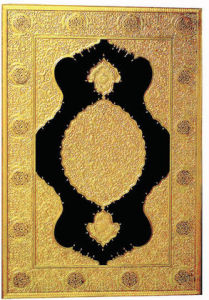Calligrapher (B. 1470, Afyonkarahisar – D.
1556, Istanbul). His full name is Ahmed
ŞemseddinKarahisarî. There is not sufficient information on his family, his
training and his educational status. It is known that he went to Istanbul for
educational purposes during the first years of Bayezid II period and stayed
there until the end of his life. He practiced with the Persian Calligrapher
Esedullah-ıKirmanî who was assumed to settled to Istanbul with a group of
artists during the rule of Fâtih Sultan Mehmed. He spiritually attached himself
to a Halvetiyye sheikh named CemâleddinİshakKaramâni and upon completing his
Sufi education he became a sheikh himself. In the notes he added to his works
he indicated Esedullah-ıKirmânî as his master. Karahisarî passed away around
the age of ninety. He was inhumed in the garden of the dervish lodge of
CemâleddinİshakKaramâni in Sütlüce. Hüdâyî Mustafa Efendi dated his death with
the verse “GeçtihayfâKarahisârî- ipir” (963).
In biography collections it is stated that
Karahisârî was a live example of Sufi morality, he lived a devoted, modest and
simple life and he was a skilled artist in poetry and tailoring. In Celî(high
level) and müsennâ(letters with two dots) scriptures, he took YahyaSufî and Ali
b. YahyaSufî’s calligraphies of Fatih period as an example, he reached a
certain harmony in letters and compositions and presented the style which is
named after him. The shape, proportion, sequence and different page designs he
gave to letters and words made the most beautiful form of works. Karahisarî who
collected numerous artists around him with his innovations started to be known
as "Şemsü'l-hat" and “Yâkut-iRûm” in a short time. The celîsülüs,
muhakkak (exact), müsennâ and müselsel(combined)compositions he
arranged with a great ingenuity and care set an example for other
calligraphers.
Karahisarî, who continuously looked for
new compositions and shapes, had a sensitivity and accuracy of an illuminator
and he decorated the letters he wrote using gold ink with black ink and the
ones he wrote using black ink with gold ink, granted the calligraphy a new
esthetical dimension. A nesta’lik(a type of writing) plaque he drew
using a very fine black ink in a stanza which is present in Cairo Menyel Palace
Museum of Calligraphy proves that he also knew that calligraphic style.
Karahisârî authored many works in aklâm-ısitte (T.N. six pens referring
to six different calligraphy styles in Islamic Calligraphy) including mushaf(T.N.
Koran scripture), en'âm, prayer booklets and murakka. His Koran
scripture, illumination, cover and size he prepared for Kanunî Sultan Süleyman
present his most famous works, which reflect the
civilization level of that period. His works are kept in museums and libraries
such as Topkapı Palace Museum Library, Turkish and Islamic Arts Museum, Süleymaniye
Library, Istanbul University Library, Afyonkarahisar Museum.
REFERENCE:
Ekrem Hakkı Ayverdi / Fatih Devri Hattatları
ve Hat Sanatı (s. 24, 1953), Rıfkı Melûl Meriç / Türk
Nakış Sanatı Tarihi Araştırmaları (s. 58-66-68, 1953), Süheyl Ünver / Hattat Ahmed Karahisarî (1964), Ömer
Lütfı Barkan / Süleymaniye Cami ve İmareti İnşaatı
1550-1557 (1979), M. Uğur Derman / Türk Hat
Sanatının Şaheserleri (1982), Ali Alparslan / Ünlü Türk Hattatları (s. 49-64,
1992), Muhittin Serin / Hat Sanatı ue Meşhur Hattatlar (s.
109-113, 1999) - Muhittin Serin / TDV İslam Ansiklopedisi (C. 24, s. 421-424,
2001), İhsan Işık / Ünlü Sanatçılar (Türkiye Ünlüleri Ansiklopedisi, C. 5,
2013) - Encyclopedia of Turkey’s Famous People (2013).






